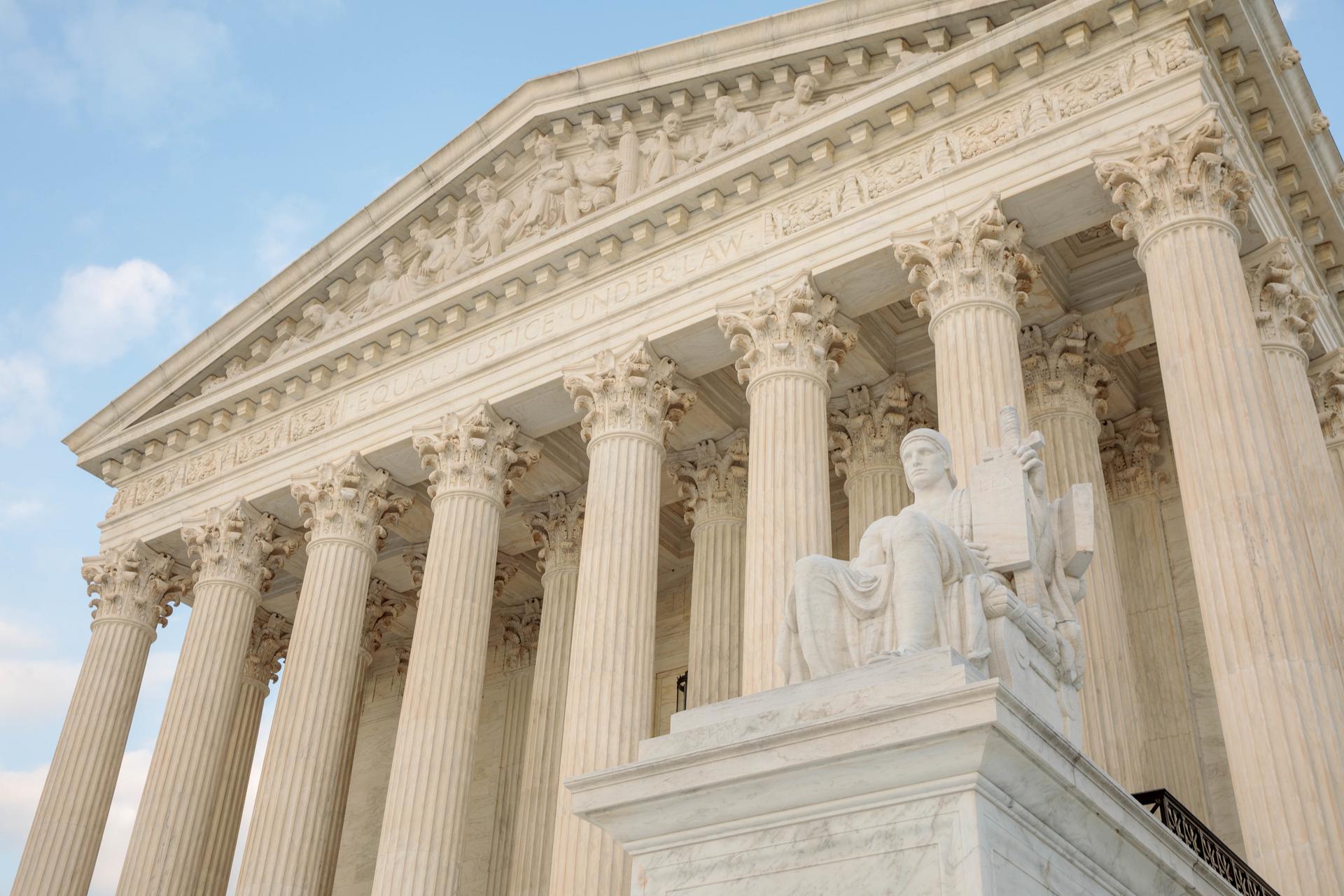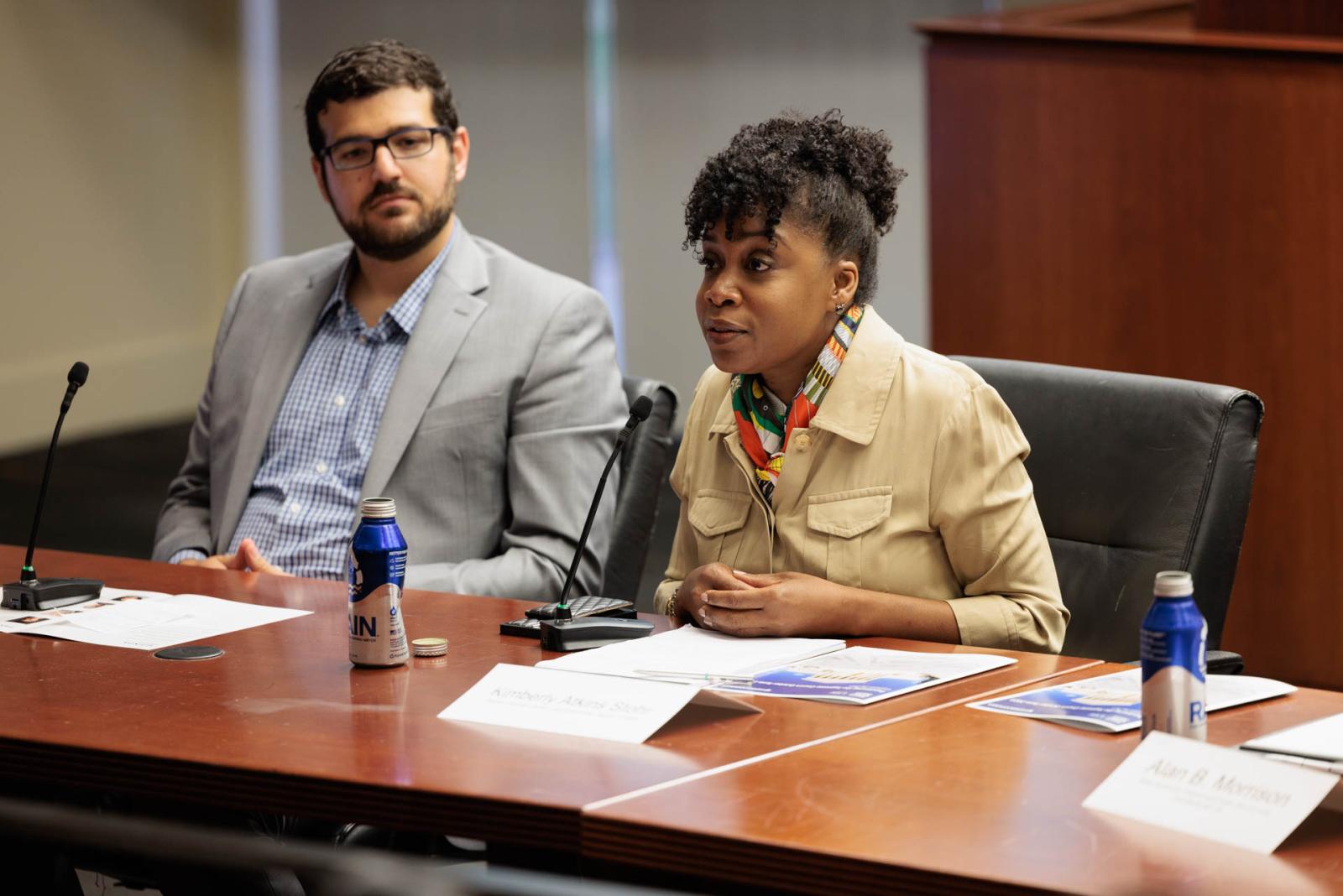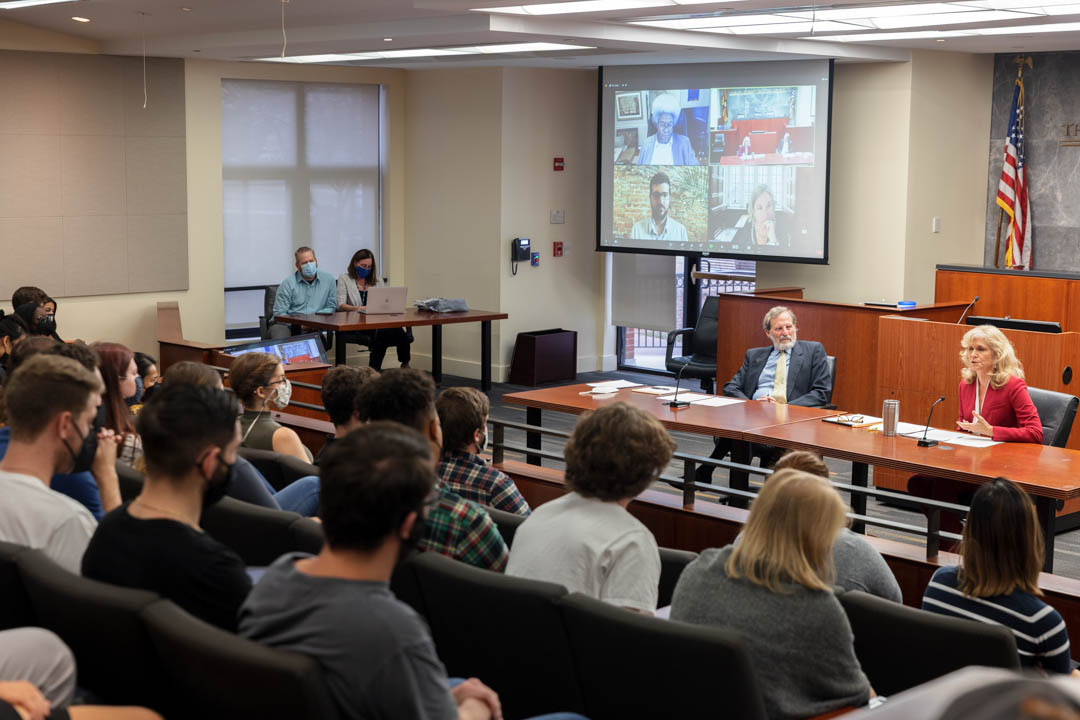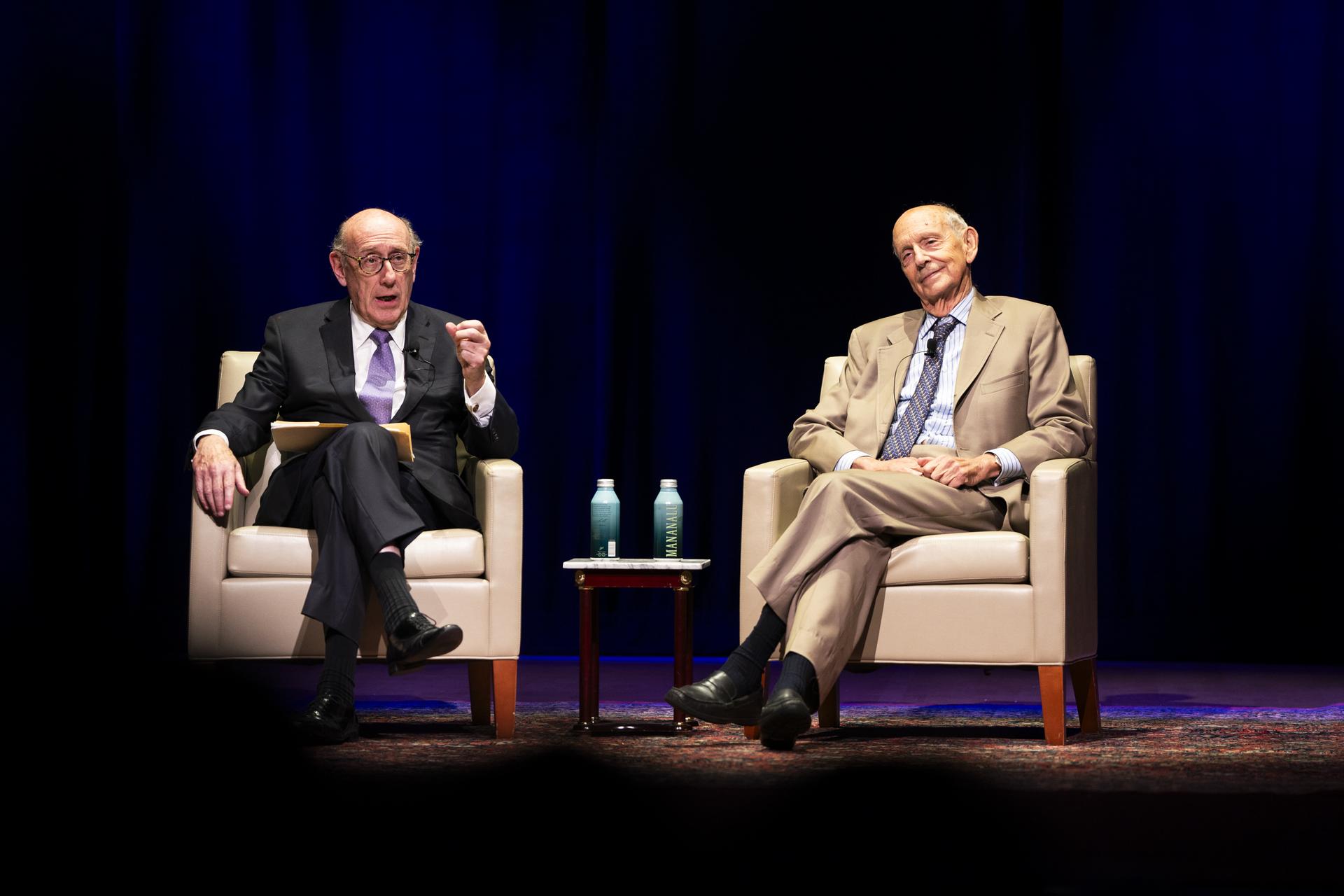An overflow crowd filled the Jacob Burns Moot Court Room to hear a panel of faculty members and legal experts discuss the cases teed up for the U.S. Supreme Court this term.
Panelists included Kimberly Atkins Stohr, senior opinion writer and columnist for Boston Globe Opinion; Emily Hammond, Glen Earl Weston Research Professor at GW Law; and Alan B. Morrison, Lerner Family Associate Dean for Public Interest and Public Service Law and Professorial Lecturer in Law. The discussion was moderated by legal analyst Mark Joseph Stern, a senior writer for Slate, returning for the seventh time to moderate this annual GW event.
Brief welcomes were offered by Dayna Bowen Matthew, GW Law dean, and Provost Christopher Alan Bracey, both of whom expressed delight at seeing the standing-room-only crowd.
“One of the reasons this event is so important,” Matthew said, “is because you as students get to see our faculty and people outside our faculty talking about the law in informal and passionate ways.”
“It behooves you all to know what's going on in the Supreme Court,” Bracey said, “and appreciate the impact that those court decisions can have on your daily life.”
Several significant Supreme Court cases, past and present, were touched on throughout the event, which was held in honor of Constitution Day, an annual remembrance of the signing of the U.S. Constitution in Philadelphia in September 1787. Each panelist highlighted one case of particular interest before brief considerations of other cases and a Q & A session.
Gerrymandering in South Carolina: political or racial?
Stohr began with a discussion of Alexander v. South Carolina State Conference of the NAACP, a case stemming from a redrawn congressional map adopted by the Republican-controlled legislature of South Carolina. The redistricting map moves tens of thousands of Black voters to a different district.
“The central question is basically whether the district court in this case erred in finding that race was a predominant factor in the drawing of South Carolina’s First Congressional District,” Stohr said.
In a previous case, Rucho v. Common Cause, the U.S. Supreme Court ruled that federal courts have no jurisdiction to consider political gerrymandering claims. South Carolina is claiming that its new map was motivated by political and not racial considerations. The problem, Stohr said, particularly in Southern states, is that there’s really no way to distinguish between political and racial gerrymanders.
“The biggest takeaway in this case is that it’s the Supreme Court’s first real opportunity to articulate the difference between a racial gerrymander and a political gerrymander,” Stohr said. “That's important because it prevents what the challengers are alleging here, that this is just a post hoc justification for doing a racial gerrymander. If that is allowed to continue, that basically creates a road map to do racial gerrymandering throughout the United States in a way that is disguised as political gerrymandering.”
SCOTUS looks at social media
Morrison discussed Moody v. NetChoice, LLC and a handful of other cases involving social media. The questions at issue in Moody are whether the First Amendment prohibits states from requiring that social-media companies host third-party communications and from regulating the circumstances in which they do so, and whether the First Amendment prohibits a state from requiring social-media companies to explain to users when they censor the user’s content or speech.
Some of the cases he discussed, Morrison said, “go back to a time when Donald Trump was the president, and he was using Twitter essentially as his official organ of the presidency. And he decided he didn't like some of the people who were responding to his tweets and blocked them from doing so.”
When Trump’s critics went to court, the Second Circuit ruled that since Trump was running this Twitter account in his official capacity as the president, he was violating the First Amendment by discriminating against people based on their viewpoint.
“By the time the case got to the Supreme Court, Trump was no longer the president,” Morrison said. “The case was moot but it left open the big question: How much is enough? There are two cases, in two different circuits. In one case, the elected official was found to be engaged in official action and therefore was subject to the First Amendment. In the other case, they found they were not engaged. The Supreme Court has got these two cases up with similar, somewhat overlapping fact patterns. The question is, how much is too much? And in a nice lawyer-like fashion, the court will say it depends. The question is what does it depend on? … It's an important First Amendment question.”
In a second pair of cases, Morrison said, “Florida and Texas decided that the big media companies were being unfair by taking down political advertisements, particularly of a conservative kind. And so they passed very similar laws in both states, which essentially say that social media companies are not allowed to take those ads down. And of course, if you must carry them in Florida or in Texas, you must carry them throughout the United States and the world. So, in essence, they are dictating media policy for the entire country.”
The remaining case in Morrison’s cluster of five social media cases involves efforts by the Biden administration to persuade social media outlets to take down false and misleading information about COVID and at the same time to encourage them to put up certain information the administration deemed important from a public health perspective. A number of individuals filed a lawsuit.
“The district judge gave the objectors a grand slam home run,” Morrison said, “and ruled that the administration essentially can't talk to social media companies at all. The government took an appeal to the Fifth Circuit, which said it’s OK to persuade but not to coerce, without explaining to anybody what the difference is between those two.”
Several questions arise from these cases. Should efforts by the government to ban anti-vaccine information on social media be viewed as censorship? What about hate speech? In the opposite direction, what about efforts by the federal government to inform social media users about reproductive health options?
Fish story, or why administrative law is exciting
The case presented by Hammond, Loper Bright Enterprises v. Raimondo, arose when a group of commercial herring fishermen sued the National Marine Fisheries Service after it required the fishing industry to fund at-sea monitoring programs. The fishermen argued that the Service lacked the authority to create industry-funded monitoring requirements and that it had not followed rulemaking procedure.
Major questions arising from this case are whether the National Marine Fisheries Service can require industry to pay for at-sea monitoring programs and whether the Supreme Court should overrule Chevron v. Natural Resources Defense Council or at least clarify whether statutory silence on controversial powers must result in deference to the federal agency.
“Depending on how you look at it, this case is either about interpreting a statute or it's about power,” Hamond said. “It's about who has power among the three branches [of government].”
The National Marine Fisheries Service requires monitors to be aboard on about half of the total number of herring fishery vessels. Typically, following Chevron, in cases where specific powers were challenged but not spelled out in statute, courts have deferred to federal agencies.
“On the first day of my administrative law class, I tell students I love administrative law because it's about power,” Hammond said. “Is it the agency who has the power, with the understanding that Congress, with its powers, gave that authority to the agency? Or is the court going to take it all?”
A loaded gun rights case
Concluding the main discussion, Stern presented United States v. Rahimi, which asks if prohibiting persons subject to domestic violence restraining orders from possessing a firearm violates the Second Amendment. Stern began by referring to Justice Clarence Thomas’s opinion in a previous gun rights case, New York State Rifle & Pistol Association v. Bruen, requiring states to issue “concealed carry” permits to law-abiding, responsible citizens.
“The majority in Bruen, through Thomas, said that if the government cannot find a sufficient number of historical analogs in the constitution to justify contemporary gun law, that law is unconstitutional and the courts have an obligation to strike it down,” Stern said.
The defendant in the Rahimi case was charged with a number of crimes including possessing a firearm while under a civil protective order entered against him by an ex-girlfriend.
“If you are under a restraining order, you are not allowed to possess a firearm for reasons that I think are probably too obvious to state,” Stern said. “In this country in particular, there is a crisis of violence—of specifically men using firearms to murder their intimate partners and children. A disproportionate number of mass shooters committed domestic violence before or during their spree. When there is a gun in the house or in possession of the domestic abuser, the partner is vastly more likely to be murdered.”
The Fifth Circuit, he said, disregarded these issues in Rahimi because of the Thomas opinion in Bruen regarding the need for historical analogs to justify restrictions on Second Amendment freedoms. For much of America’s history, domestic abuse was legal. Women were not equal citizens deemed to have rights apart from their husbands.
Justice Thomas’s opinion in Bruen has been used to invalidate other contemporary gun restrictions, Stern said, such as a lower court’s striking down a ban on scratching out the serial number on a firearm.
Stern said the Rahimi case invokes echoes of the Dobbs decision in which the Supreme Court said that women don’t have a constitutional right to reproductive autonomy since they didn’t have reproductive rights historically.
“This is a really big question,” Stern said, “of how intensively the court wants to root modern doctrine in history, because history is not always a positive thing to look to when interpreting the law, to put it quite mildly. And in this particular case, following history will undoubtedly lead to the deaths of many women and children.”
Despite the Thomas opinion in Bruen, Stern’s best guess—partly based on his reading of Justice Brett Kavanaugh’s character—is that the court will not affirm the Fifth Circuit ruling, instead upholding the law that makes it a crime to possess a firearm if you are under a restraining order.
“Justice Kavanaugh in particular has a clear, deep, gnawing desire to be admired,” Stern said. “He wants good headlines. He wants to be viewed as a kind of thoughtful justice. And he also likes for the world to know that he is a girl dad. He has two daughters and he coaches girls’ basketball. And he has expressed a desire to uphold the court’s equal protection jurisprudence when it comes to women's rights. He joined an opinion by Justice Sotomayor indicating that it's unconstitutional to exclude women from draft registration. But on the other hand, he joined a decision like Dobbs, which basically says the state can transform women into vessels for unwanted pregnancies. I do think there are two parts of Justice Kavanaugh pulling at him in these kinds of cases. And I don’t think he can really have it both ways.”







